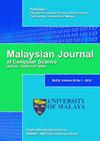SEMANTIC GRAPH KNOWLEDGE REPRESENTATION FOR AL-QURAN VERSES BASED ON WORD DEPENDENCIES
IF 1.2
4区 计算机科学
Q4 COMPUTER SCIENCE, ARTIFICIAL INTELLIGENCE
引用次数: 2
Abstract
Semantic approaches present an efficient, detailed and easily understandable representation of knowledge from documents. Al-Quran contains a vast amount of knowledge that needs appropriate knowledge extraction. A semantic based approach can help in designing an efficient and explainable knowledge representation model for Al-Quran. This research aims to propose a semantic-graph knowledge representation model for verses of Al-Quran based on word dependencies. These features are used in the proposed knowledge representation model allowing the semantic graph matching to improve Al-Quran search applications' accuracy. The proposed knowledge representation model is essentially a formalism for generating a semantic graph representation of Quranic verses, which can be applied for knowledge base construction for other applications such as information retrieval system. A set of rules called Semantic Dependency Triple Rules are defined to be mapped into the semantic graph representing the verse's logic. The rules translate word dependencies and other NLP metadata into a triple form that holds logical information. The proposed model has been tested with English translation of Al-Quran on a document retrieval prototype The basic system has been enhanced with anaphoric pronouns correction, which has shown improvement in retrieval performance. The results have been compared with a closely related system and evaluated on the accuracy of the document retrieval in Precision, Recall and F-score measurements. The proposed model has achieved 65%, 60% and 62.4% for the measurements, respectively. It has also improved the overall accuracy of previous system by 43.8%.基于词相关性的AL-QURAN诗句语义图知识表示
语义方法提供了一种高效、详细且易于理解的文档知识表示。《古兰经》包含了大量需要适当提取知识的知识。基于语义的方法可以帮助为《古兰经》设计一个高效且可解释的知识表示模型。本研究旨在提出一个基于单词依赖性的《古兰经》诗句语义图知识表示模型。这些特征被用于所提出的知识表示模型,允许语义图匹配来提高Al-Quran搜索应用程序的准确性。所提出的知识表示模型本质上是一种用于生成古兰经诗句的语义图表示的形式主义,可用于其他应用程序(如信息检索系统)的知识库构建。定义了一组称为语义依赖三重规则的规则,将其映射到表示诗句逻辑的语义图中。这些规则将单词相关性和其他NLP元数据转换为包含逻辑信息的三重形式。该模型已在文献检索原型上用《古兰经》的英文翻译进行了测试。回指代词校正增强了基本系统,显示出检索性能的提高。将结果与一个密切相关的系统进行了比较,并在精度、召回率和F评分测量中对文档检索的准确性进行了评估。所提出的模型分别获得了65%、60%和62.4%的测量结果。它还将以前系统的总体精度提高了43.8%。
本文章由计算机程序翻译,如有差异,请以英文原文为准。
求助全文
约1分钟内获得全文
求助全文
来源期刊

Malaysian Journal of Computer Science
COMPUTER SCIENCE, ARTIFICIAL INTELLIGENCE-COMPUTER SCIENCE, THEORY & METHODS
CiteScore
2.20
自引率
33.30%
发文量
35
审稿时长
7.5 months
期刊介绍:
The Malaysian Journal of Computer Science (ISSN 0127-9084) is published four times a year in January, April, July and October by the Faculty of Computer Science and Information Technology, University of Malaya, since 1985. Over the years, the journal has gained popularity and the number of paper submissions has increased steadily. The rigorous reviews from the referees have helped in ensuring that the high standard of the journal is maintained. The objectives are to promote exchange of information and knowledge in research work, new inventions/developments of Computer Science and on the use of Information Technology towards the structuring of an information-rich society and to assist the academic staff from local and foreign universities, business and industrial sectors, government departments and academic institutions on publishing research results and studies in Computer Science and Information Technology through a scholarly publication. The journal is being indexed and abstracted by Clarivate Analytics'' Web of Science and Elsevier''s Scopus
 求助内容:
求助内容: 应助结果提醒方式:
应助结果提醒方式:


